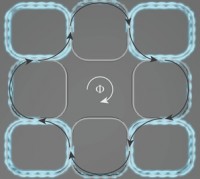
Topological light travels easily around the edge of the lattice, yet it gets muddled in the middle. (Courtesy: JQI)
By Hamish Johnston
Last year we reported on a fascinating experiment that simulated the quantum Hall effect using light. Mohammad Hafezi and colleagues at the Joint Quantum Institute (JQI) of the University of Maryland created a lattice of ring-shaped silicon waveguides that are placed just nanometres apart (see image above). This allows light in one ring to “tunnel” into a neighbouring ring and make its way across the matrix, hopping from ring to ring.
This orbiting and hopping is analogous to the effect of a magnetic field on electrons in a thin sheet of semiconductor – which is where the quantum Hall effect (QHE) is usually observed. In the presence of a magnetic field, QHE electrons travel in circular orbits. In the middle of the sheet these orbits are localized, so the semiconductor behaves as an electrical insulator. However at the edges of the sheet the circular orbits are interrupted and electrons are forced to hop from one orbit to the next, making conduction possible.
This edge conduction was simulated by making the lattice out of two slightly different rings that are arranged in square unit cells as illustrated by the image on the right. One type of ring is tuned to resonate with the light used in the experiment. This means that the light can travel around an isolated ring forever, at least in principle. The other type of ring is detuned slightly from the light, which encourages light to jump to a neighbouring ring.
This arrangement makes it much more likely that light circulating in a specific direction – say clockwise – will travel along the edges of the lattice. Indeed, when light is introduced at one corner of the lattice, most of the light appears to follow one edge around the lattice and pops out the other side. Any light that ventures into the middle of the lattice appears to take a random path before fizzling out.
Furthermore, if one of the unit cells of the lattice is removed from the edge, the light will detour around the “defect”. This is exactly what happens in a QHE material and is a property called topological protection.
Now, Hafezi and colleagues have published a follow-up paper that will appear this month in Physical Review Letters and is already available on the arXiv preprint server with the catchy title “Topologically robust transport of photons in a synthetic gauge field”. The researchers say that they have used the “gold standard for localization studies” to confirm that the edges of the matrix are indeed topologically protected. This was done by doing a statistical analysis of the transmission and delay of light as it travelled along various routes in the matrix. The study confirmed that light in the middle of the lattice is localized, whereas it flows with ease along the edges.
As well as providing a useful and experimentally accessible simulation of topological protection, the concept could also be used in optical components for computing and telecommunications.

Trackback: Physics Viewpoint | Shining a brighter light on topological transport
For the QHE the electron states in a plate are the Landau synchrotron quantised states due to the presence of the magnetice field orthognal to the plate surfance. For the photons, the lattice ring does the “quantising” and the topological- transport job.